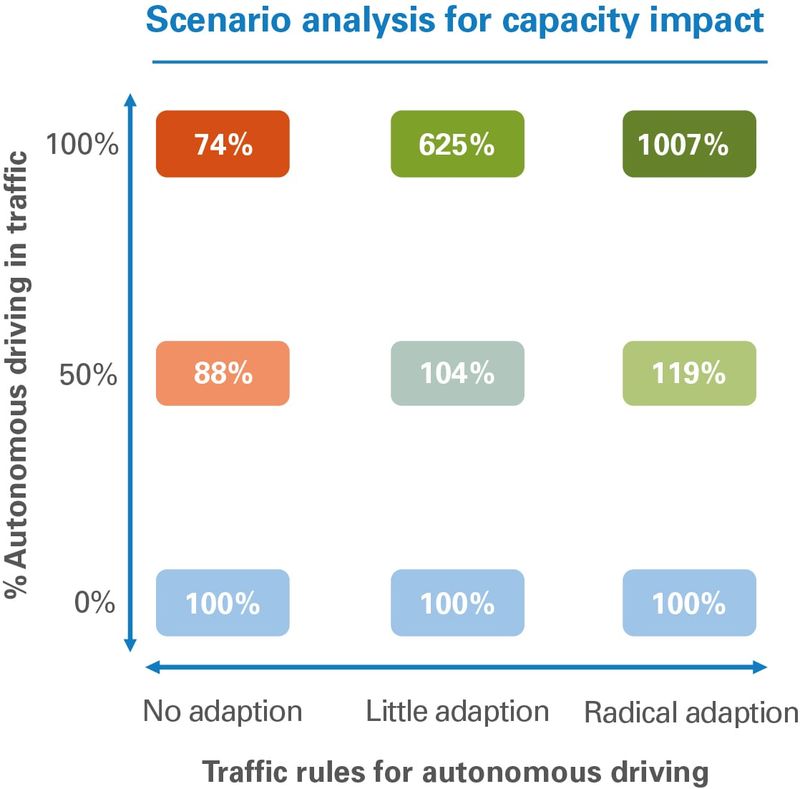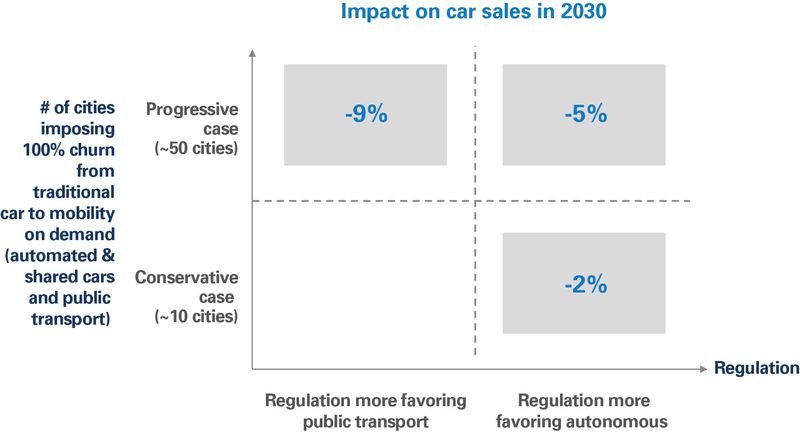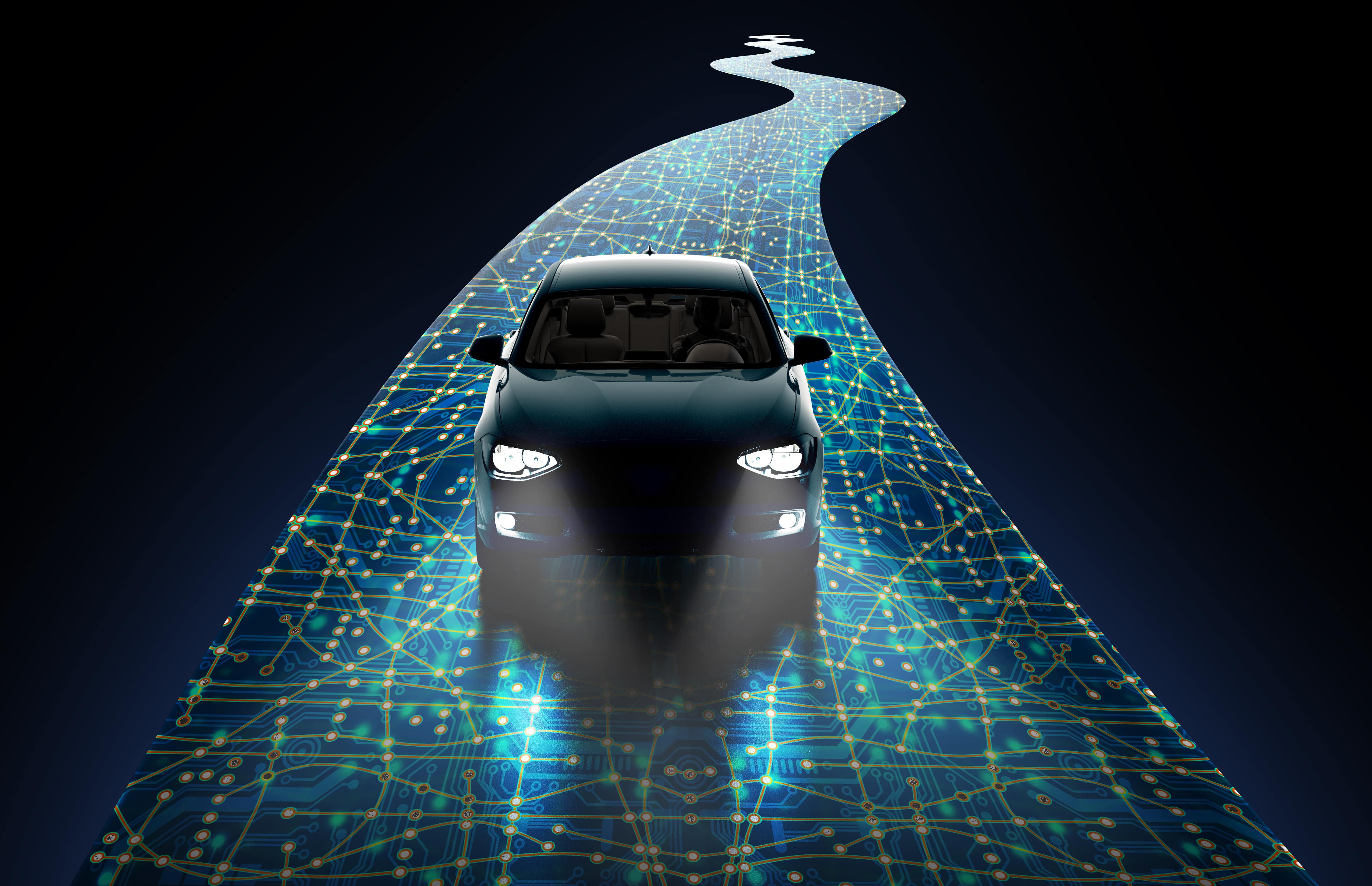DOWNLOAD
11 min read •
The march of the robo-taxis
Radical disruption or gridlock?

Traffic congestion has a major impact on air quality, health and productivity in cities across the globe. Zero-emission vehicles, autonomous driving and new mobility models are billed as providing solutions to this problem, but will they work in practice? Drawing on a unique combination of real-world modeling, consumer research and trend analysis, this article outlines the impact of these developments on drivers, car manufacturers, regulators and public transportation providers.
Traffic congestion is a severe problem in major cities around the world, increasing pollution and adversely impacting health and overall quality of life. The drive for zero-emission vehicles, the rise of autonomous cars, and new mobility models promise to improve air quality and potentially reduce congestion. Autonomous, zero-emission robo-taxis ferrying passengers around the city seem, at first sight, to offer an attractive solution to the problem. But will they work? Based on detailed consumer research, modeling and analysis, this article provides some surprising conclusions, and sets out the stark implications for regulators, transport providers and automotive manufacturers.
 Dealing with congestion and pollution
Dealing with congestion and pollution
Cities worldwide are heavily affected by traffic congestion. Time spent sitting in jams varies from over 200 hours per year in the worst-affected locations, such as Mexico City, Rome and Beijing, to around 150 hours in medium-affected cities such as Berlin. Individual journeys in peak hours in heavily affected cities take over twice as long as they should due to congestion.
As congestion affects citizens’ quality of life and creates sustainability issues, regulators have developed a large amount of tools to limit car use, which range from congestion tolls and expensive or limited parking to licensing smaller amounts of number plates. This means people are, to a certain degree, already moving away from car ownership and usage in cities, which is heavily impacting the business models of players along the mobility value chain, from vehicle manufacturers to mobility and public transportation providers. Currently, three trends are accelerating transformative change in automotive: zero-emission vehicles, autonomous driving and new mobility models. Autonomous, zero-emission robo-taxis embody all three of these trends, offering the potential for convenient, personalized transport as an attractive alternative to owning a car or using public transport. However, understanding the impact that robo-taxis would have is not straightforward. Our analysis has looked at three questions:
- What would be the impact of robo-taxis on traffic volumes and congestion?
- What would be the likely consumer demand for robo-taxis?
- What are the implications for automotive companies, regulators and public transport providers?
Robo-taxis will increase congestion unless there are accompanying radical changes in regulation
For regulators needing to pursue the right policies for future urban mobility, vehicles in general currently generate three issues: congestion, pollution and safety, in particular the risk of injury to drivers and pedestrians. While the rise of autonomous, zero-emission vehicles reduces or minimizes the last two of these, it brings other challenges around congestion. Robo-taxis are likely to increase the number of journeys, due to not only their convenience (e.g., no parking problems, no need for a driving license, the ability to drink), but also the empty collecting trips, which would, in theory, more than double the number of journeys altogether. Considering that the capacity of streets themselves is likely to remain unchanged, such a traffic increase would be unfeasible in most cities of the world.
However, robo-taxis also provide an opportunity to significantly increase traffic capacity by reducing safe stopping distances between cars. As robots can react almost instantly, it is reasonable to reduce the enforced safe distance while still expecting higher safety levels.
So what would be the likely overall net impact on capacity and congestion? To explore this question, we developed an in-depth mathematical model to simulate the capacity impact of autonomous cars, based on a representative typical real- life intersection located in Frankfurt. While further research is still necessary, the model does provide meaningful guidance on the magnitude of the impact of autonomous vehicles on a macro scale. The research looked at the traffic capacity in multiple scenarios, based on two factors:
- The percentage of autonomous and human-driven vehicles involved (i.e., 100 percent autonomous versus 50/50 autonomous and human).
- Adaption of traffic rules to maximize capacity for autonomous vehicles (i.e., no adaptation, little adaptation or radical adaptation).
The overall results are summarized in Figure 1 below.

As may be seen from Figure 1, the key finding from the simulation was that with 100 percent autonomous driving, along with radical adaptation of traffic rules to suit autonomous driving, capacity would increase by a factor of 10 in most situations compared to today. If we then add in further safety margins, we still arrive at a capacity increase of at least a factor of five.
By contrast, with 100 percent autonomous driving and no rule adaptation, capacity would actually shrink by around 25 percent due to today’s rules around safe stopping distances, which are based on human behaviors. Modest adaptation would also increase capacity, but not by as much.
However, in mixed traffic, in which autonomous vehicles and human drivers would share the road, and with current traffic rules, traffic capacity would also decrease. On average, humans tend to drive above the speed limit and maintain safety gaps that are too short. As autonomous vehicles automatically obey the law, this noticeably slows down traffic flow in our dynamic simulation – essentially, they are “bullied” by human drivers. In mixed traffic, traffic rule adaptation would only provide a slight increase in capacity.
In summary, the only way to effectively address street capacity problems with autonomous vehicles is to switch to 100 percent autonomous driving and reduce safety distances between cars. Our findings imply that getting rid of congestion and allowing for the convenience of robo-taxis would therefore be primarily a matter of political and regulatory choice. It would require deep understanding of the mobility profile of the city, existing vehicle density, geography, and traffic systems. Policy decisions would be tough to make. Effectively, the price for getting rid of congestion and enjoying the other benefits of robo-taxis would be to render public transport more unattractive and radically forbid human-driven vehicles, at least in peak time or on peak roads. This would impact the ownership rights and behavior of millions of people.
Our calculations show that new robo-taxi models might be cheaper than existing public transport, even if the latter is subsidized. Cities and societies would therefore need to make some difficult choices:
- If robo-taxi fleets would be clean, nearly error free and probably traffic-jam free, aren’t they an ideal mobility solution to replace both public transport and regular cars?
- Is a city willing to exploit this potential by embracing the disruption to norms that it would bring?
- If a city is not willing, how would this impact competitiveness in comparison with those that would opt for this type of mobility and accept its consequences?
Robo-taxis have the potential to attract high demand
While the traffic congestion analysis above assumes that there will ultimately be substitution of conventional vehicles by autonomous vehicles, it is important also to understand whether consumers will actually want to travel in autonomous robo-taxis. In 2018, Arthur D. Little conducted a worldwide consumer survey in 13 countries around automotive megatrends, and this unique data set provides a valuable indication of the likely demand. Among the key findings from the survey, we found that:
- Consumers without cars would be likely to use autonomous vehicle-based mobility services to replace journeys by both conventional car and public transport. Nearly half (45 percent) of people without regular access to cars stated they would use robo-taxis instead of public transport, with 25 percent stating they would use them instead of conventional taxis.
- However, for car owners to switch to robo-taxis, they would need to be convinced that robo-taxis would at least match the experience in the key areas of independence, comfort and convenience, which were the top three reasons consumers gave in our survey for owning a car (rated as fairly important or above by 90 percent, 88 percent and 85 percent of consumers, respectively).
Essentially, as soon as robo-taxis are perceived as being more convenient than cars – which they certainly have the potential to be – then the demand for car-based mobility will actually increase.
Robo-taxis will also be a game changer in that they will significantly increase the demand for car sharing. Today’s car-sharing usage remains niche, with nearly 70 percent of consumers never car sharing, and only 12 percent more than 10 times a month. This lack of appetite can be explained by the need for journeys to be plannable and reliable, especially journeys to and from work, which account for, on average, half of all car journeys. Robo-taxis could return by themselves from city centers to pick up other commuters during the same rush hour, in the same way public transport does today. However, as well as autonomous driving advances, this will require investment in intelligent-demand fleet management, including dispatching, advanced e-hailing and active demand steering (such as through pricing, as Uber does today), if it is to move car sharing from a niche to the mainstream.
Insight for the executive: What are the implications for automotive companies, regulators and public transport providers?
Automotive manufacturers: Overall vehicle sales impact will be limited, but manufacturers will need a balanced investment approach across new mobility.
A critical question for automotive manufacturers is how the advent of robo-taxis will affect vehicle sales. Using our survey data, we defined a macro model of the traffic of the city of Vienna based on statistical data, and scaled this to cover the major cities of the world. The impact on global vehicle sales of the advent of autonomous vehicles depends, to a large extent, on how progressive cities will be in their future mobility policies and regulation. For example:
- The proportion of the world’s major cities that will impose 100 percent adoption of mobility on demand (MOD) to replace private cars (by MOD, we mean autonomous vehicles, shared vehicles and public transport).
- Whether regulation will favor autonomous vehicles or conventional public transport.
The results of our simulation are shown in Figure 2 below.

Even in the most progressive scenario in our model, in which a high number of cities impose 100 percent MOD, the predicted global sales drop would be only 5 percent if robo- taxis were encouraged by vehicle-friendly regulation, and 9 percent in the case of unfriendly regulation. These limited reductions in volume would likely be compensated for, in any case, by additional growth in the overall automotive market; hence, it is reasonable to conclude that the impact of robo-taxis on overall vehicle sales would be limited.
One of the big challenges facing automotive manufacturers would be how to balance investment between zero-emission vehicles, autonomous driving and new mobility models. Given the scale of the figures involved, and the time and energy required for each of these transformations, which should they focus on most? Could they safely deprioritize one or more of these trends and still benefit?
The most disruptive effect of progressive robo-taxi adoption on automotive companies would be around the shift in buying power from consumers to fleet operators. Today, most car manufacturers sell directly to millions of individual consumers, along with a small number of larger fleet operators, many of which are not in the mobility business. The switch to larger robo-taxi fleets would mean huge buying power would shift to fleet operators, which would also control the customer interface with the end-user/robo-taxi passenger. These operators could be either private sector organizations or existing public transportation players.
This means investment in new mobility models (such as running their own autonomous/car-sharing fleets) would be a requirement for car manufacturers if they were to remain relevant and a key part of the automotive value chain moving forward.
However, our analysis shows that the three investment requirements for car manufacturers – new powertrains, autonomous driving and new mobility – are inextricably linked. New mobility models can only be successful when clean and autonomous driving is fully in place. That means any upfront investments in new mobility models alone are doomed to failure. An alternative strategy would be to let others make the upfront investments, concentrate on the race for autonomous driving, and then disrupt the mobility market. However, neglecting one part of these requirements risks future revenues, or in the case of new mobility models, the interface with the end user, too. Our top-line advice for car manufacturers is therefore to aim to convince regulators of the sustainability of clean, autonomous and shared vehicles in order to drive vehicle-friendly regulation.
Regulators: With the advent of robo-taxis, regulators need to be prepared to make radical and unpopular decisions to reduce congestion.
As we have seen above, investments in autonomous and new mobility rely heavily on regulatory decisions. If regulation does not adapt driving rules radically in favor of autonomous vehicles and forbid human-driven cars at least at peak times, increasing congestion will lead to an overall decrease in car use. In this scenario, investments in autonomous and new mobility would actually lead to a shrinking market, which would make them counterproductive. Strategically, car manufacturers may be forced to invest anyway, because others, especially disruptors from outside, are doing so. Regulators need to be prepared to make potentially radical and unpopular decisions if they are to reduce congestion and pollution. Do they favor autonomous vehicles over private, human-driven cars? How would they integrate robo- taxis with existing public transport? How would their cities’ competitiveness and quality of life be best served? In any case, the different mobility offerings, ranging from cars to all forms of public transport, need to be integrated and balanced in line with the specific profile of each city. This encompasses sensible regulation, demand balancing, integrated digital journey services, and alignment of schedules.
Public transport operators: Need to engage in careful forward planning with an integrated overall approach.
As shown above, in the case of autonomous vehicle-friendly regulation, public transport operators face losing significant numbers of customers to potentially cheaper and very convenient robo-taxis. Given that they are making long-term decisions today regarding infrastructure and fleet investment, they need to factor this into their thinking now. They need to understand how to counter this threat moving forward. For example, should they decide to run their own fleets of robo- taxis? Automotive OEMs and other vehicle-based mobility providers need to take an active part in this integration. Only if their offerings fit into the overall solution will they find acceptance.
To conclude, what is clear is that autonomous vehicles offer major potential benefits to citizens, but also pose significant challenges. The traditional roles of automotive manufacturers, regulators and transport operators are already starting to be disrupted. It will be interesting to see which cities are bold enough to lead the way.


Traffic congestion has a major impact on air quality, health and productivity in cities across the globe. Zero-emission vehicles, autonomous driving and new mobility models are billed as providing solutions to this problem, but will they work in practice? Drawing on a unique combination of real-world modeling, consumer research and trend analysis, this article outlines the impact of these developments on drivers, car manufacturers, regulators and public transportation providers.
Traffic congestion is a severe problem in major cities around the world, increasing pollution and adversely impacting health and overall quality of life. The drive for zero-emission vehicles, the rise of autonomous cars, and new mobility models promise to improve air quality and potentially reduce congestion. Autonomous, zero-emission robo-taxis ferrying passengers around the city seem, at first sight, to offer an attractive solution to the problem. But will they work? Based on detailed consumer research, modeling and analysis, this article provides some surprising conclusions, and sets out the stark implications for regulators, transport providers and automotive manufacturers.
 Dealing with congestion and pollution
Dealing with congestion and pollution
Cities worldwide are heavily affected by traffic congestion. Time spent sitting in jams varies from over 200 hours per year in the worst-affected locations, such as Mexico City, Rome and Beijing, to around 150 hours in medium-affected cities such as Berlin. Individual journeys in peak hours in heavily affected cities take over twice as long as they should due to congestion.
As congestion affects citizens’ quality of life and creates sustainability issues, regulators have developed a large amount of tools to limit car use, which range from congestion tolls and expensive or limited parking to licensing smaller amounts of number plates. This means people are, to a certain degree, already moving away from car ownership and usage in cities, which is heavily impacting the business models of players along the mobility value chain, from vehicle manufacturers to mobility and public transportation providers. Currently, three trends are accelerating transformative change in automotive: zero-emission vehicles, autonomous driving and new mobility models. Autonomous, zero-emission robo-taxis embody all three of these trends, offering the potential for convenient, personalized transport as an attractive alternative to owning a car or using public transport. However, understanding the impact that robo-taxis would have is not straightforward. Our analysis has looked at three questions:
- What would be the impact of robo-taxis on traffic volumes and congestion?
- What would be the likely consumer demand for robo-taxis?
- What are the implications for automotive companies, regulators and public transport providers?
Robo-taxis will increase congestion unless there are accompanying radical changes in regulation
For regulators needing to pursue the right policies for future urban mobility, vehicles in general currently generate three issues: congestion, pollution and safety, in particular the risk of injury to drivers and pedestrians. While the rise of autonomous, zero-emission vehicles reduces or minimizes the last two of these, it brings other challenges around congestion. Robo-taxis are likely to increase the number of journeys, due to not only their convenience (e.g., no parking problems, no need for a driving license, the ability to drink), but also the empty collecting trips, which would, in theory, more than double the number of journeys altogether. Considering that the capacity of streets themselves is likely to remain unchanged, such a traffic increase would be unfeasible in most cities of the world.
However, robo-taxis also provide an opportunity to significantly increase traffic capacity by reducing safe stopping distances between cars. As robots can react almost instantly, it is reasonable to reduce the enforced safe distance while still expecting higher safety levels.
So what would be the likely overall net impact on capacity and congestion? To explore this question, we developed an in-depth mathematical model to simulate the capacity impact of autonomous cars, based on a representative typical real- life intersection located in Frankfurt. While further research is still necessary, the model does provide meaningful guidance on the magnitude of the impact of autonomous vehicles on a macro scale. The research looked at the traffic capacity in multiple scenarios, based on two factors:
- The percentage of autonomous and human-driven vehicles involved (i.e., 100 percent autonomous versus 50/50 autonomous and human).
- Adaption of traffic rules to maximize capacity for autonomous vehicles (i.e., no adaptation, little adaptation or radical adaptation).
The overall results are summarized in Figure 1 below.

As may be seen from Figure 1, the key finding from the simulation was that with 100 percent autonomous driving, along with radical adaptation of traffic rules to suit autonomous driving, capacity would increase by a factor of 10 in most situations compared to today. If we then add in further safety margins, we still arrive at a capacity increase of at least a factor of five.
By contrast, with 100 percent autonomous driving and no rule adaptation, capacity would actually shrink by around 25 percent due to today’s rules around safe stopping distances, which are based on human behaviors. Modest adaptation would also increase capacity, but not by as much.
However, in mixed traffic, in which autonomous vehicles and human drivers would share the road, and with current traffic rules, traffic capacity would also decrease. On average, humans tend to drive above the speed limit and maintain safety gaps that are too short. As autonomous vehicles automatically obey the law, this noticeably slows down traffic flow in our dynamic simulation – essentially, they are “bullied” by human drivers. In mixed traffic, traffic rule adaptation would only provide a slight increase in capacity.
In summary, the only way to effectively address street capacity problems with autonomous vehicles is to switch to 100 percent autonomous driving and reduce safety distances between cars. Our findings imply that getting rid of congestion and allowing for the convenience of robo-taxis would therefore be primarily a matter of political and regulatory choice. It would require deep understanding of the mobility profile of the city, existing vehicle density, geography, and traffic systems. Policy decisions would be tough to make. Effectively, the price for getting rid of congestion and enjoying the other benefits of robo-taxis would be to render public transport more unattractive and radically forbid human-driven vehicles, at least in peak time or on peak roads. This would impact the ownership rights and behavior of millions of people.
Our calculations show that new robo-taxi models might be cheaper than existing public transport, even if the latter is subsidized. Cities and societies would therefore need to make some difficult choices:
- If robo-taxi fleets would be clean, nearly error free and probably traffic-jam free, aren’t they an ideal mobility solution to replace both public transport and regular cars?
- Is a city willing to exploit this potential by embracing the disruption to norms that it would bring?
- If a city is not willing, how would this impact competitiveness in comparison with those that would opt for this type of mobility and accept its consequences?
Robo-taxis have the potential to attract high demand
While the traffic congestion analysis above assumes that there will ultimately be substitution of conventional vehicles by autonomous vehicles, it is important also to understand whether consumers will actually want to travel in autonomous robo-taxis. In 2018, Arthur D. Little conducted a worldwide consumer survey in 13 countries around automotive megatrends, and this unique data set provides a valuable indication of the likely demand. Among the key findings from the survey, we found that:
- Consumers without cars would be likely to use autonomous vehicle-based mobility services to replace journeys by both conventional car and public transport. Nearly half (45 percent) of people without regular access to cars stated they would use robo-taxis instead of public transport, with 25 percent stating they would use them instead of conventional taxis.
- However, for car owners to switch to robo-taxis, they would need to be convinced that robo-taxis would at least match the experience in the key areas of independence, comfort and convenience, which were the top three reasons consumers gave in our survey for owning a car (rated as fairly important or above by 90 percent, 88 percent and 85 percent of consumers, respectively).
Essentially, as soon as robo-taxis are perceived as being more convenient than cars – which they certainly have the potential to be – then the demand for car-based mobility will actually increase.
Robo-taxis will also be a game changer in that they will significantly increase the demand for car sharing. Today’s car-sharing usage remains niche, with nearly 70 percent of consumers never car sharing, and only 12 percent more than 10 times a month. This lack of appetite can be explained by the need for journeys to be plannable and reliable, especially journeys to and from work, which account for, on average, half of all car journeys. Robo-taxis could return by themselves from city centers to pick up other commuters during the same rush hour, in the same way public transport does today. However, as well as autonomous driving advances, this will require investment in intelligent-demand fleet management, including dispatching, advanced e-hailing and active demand steering (such as through pricing, as Uber does today), if it is to move car sharing from a niche to the mainstream.
Insight for the executive: What are the implications for automotive companies, regulators and public transport providers?
Automotive manufacturers: Overall vehicle sales impact will be limited, but manufacturers will need a balanced investment approach across new mobility.
A critical question for automotive manufacturers is how the advent of robo-taxis will affect vehicle sales. Using our survey data, we defined a macro model of the traffic of the city of Vienna based on statistical data, and scaled this to cover the major cities of the world. The impact on global vehicle sales of the advent of autonomous vehicles depends, to a large extent, on how progressive cities will be in their future mobility policies and regulation. For example:
- The proportion of the world’s major cities that will impose 100 percent adoption of mobility on demand (MOD) to replace private cars (by MOD, we mean autonomous vehicles, shared vehicles and public transport).
- Whether regulation will favor autonomous vehicles or conventional public transport.
The results of our simulation are shown in Figure 2 below.

Even in the most progressive scenario in our model, in which a high number of cities impose 100 percent MOD, the predicted global sales drop would be only 5 percent if robo- taxis were encouraged by vehicle-friendly regulation, and 9 percent in the case of unfriendly regulation. These limited reductions in volume would likely be compensated for, in any case, by additional growth in the overall automotive market; hence, it is reasonable to conclude that the impact of robo-taxis on overall vehicle sales would be limited.
One of the big challenges facing automotive manufacturers would be how to balance investment between zero-emission vehicles, autonomous driving and new mobility models. Given the scale of the figures involved, and the time and energy required for each of these transformations, which should they focus on most? Could they safely deprioritize one or more of these trends and still benefit?
The most disruptive effect of progressive robo-taxi adoption on automotive companies would be around the shift in buying power from consumers to fleet operators. Today, most car manufacturers sell directly to millions of individual consumers, along with a small number of larger fleet operators, many of which are not in the mobility business. The switch to larger robo-taxi fleets would mean huge buying power would shift to fleet operators, which would also control the customer interface with the end-user/robo-taxi passenger. These operators could be either private sector organizations or existing public transportation players.
This means investment in new mobility models (such as running their own autonomous/car-sharing fleets) would be a requirement for car manufacturers if they were to remain relevant and a key part of the automotive value chain moving forward.
However, our analysis shows that the three investment requirements for car manufacturers – new powertrains, autonomous driving and new mobility – are inextricably linked. New mobility models can only be successful when clean and autonomous driving is fully in place. That means any upfront investments in new mobility models alone are doomed to failure. An alternative strategy would be to let others make the upfront investments, concentrate on the race for autonomous driving, and then disrupt the mobility market. However, neglecting one part of these requirements risks future revenues, or in the case of new mobility models, the interface with the end user, too. Our top-line advice for car manufacturers is therefore to aim to convince regulators of the sustainability of clean, autonomous and shared vehicles in order to drive vehicle-friendly regulation.
Regulators: With the advent of robo-taxis, regulators need to be prepared to make radical and unpopular decisions to reduce congestion.
As we have seen above, investments in autonomous and new mobility rely heavily on regulatory decisions. If regulation does not adapt driving rules radically in favor of autonomous vehicles and forbid human-driven cars at least at peak times, increasing congestion will lead to an overall decrease in car use. In this scenario, investments in autonomous and new mobility would actually lead to a shrinking market, which would make them counterproductive. Strategically, car manufacturers may be forced to invest anyway, because others, especially disruptors from outside, are doing so. Regulators need to be prepared to make potentially radical and unpopular decisions if they are to reduce congestion and pollution. Do they favor autonomous vehicles over private, human-driven cars? How would they integrate robo- taxis with existing public transport? How would their cities’ competitiveness and quality of life be best served? In any case, the different mobility offerings, ranging from cars to all forms of public transport, need to be integrated and balanced in line with the specific profile of each city. This encompasses sensible regulation, demand balancing, integrated digital journey services, and alignment of schedules.
Public transport operators: Need to engage in careful forward planning with an integrated overall approach.
As shown above, in the case of autonomous vehicle-friendly regulation, public transport operators face losing significant numbers of customers to potentially cheaper and very convenient robo-taxis. Given that they are making long-term decisions today regarding infrastructure and fleet investment, they need to factor this into their thinking now. They need to understand how to counter this threat moving forward. For example, should they decide to run their own fleets of robo- taxis? Automotive OEMs and other vehicle-based mobility providers need to take an active part in this integration. Only if their offerings fit into the overall solution will they find acceptance.
To conclude, what is clear is that autonomous vehicles offer major potential benefits to citizens, but also pose significant challenges. The traditional roles of automotive manufacturers, regulators and transport operators are already starting to be disrupted. It will be interesting to see which cities are bold enough to lead the way.



